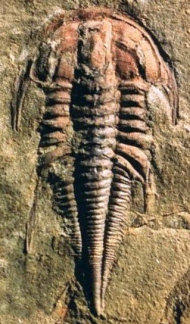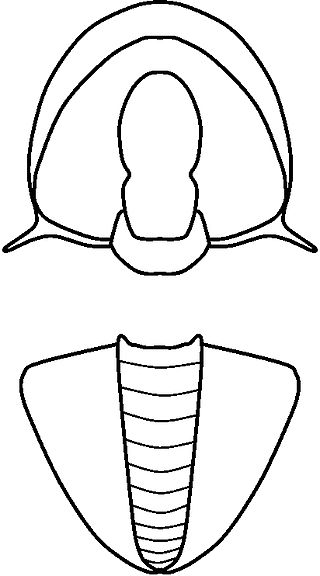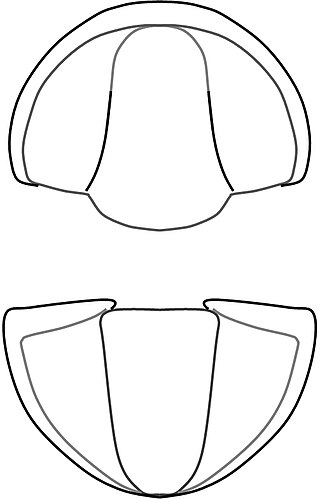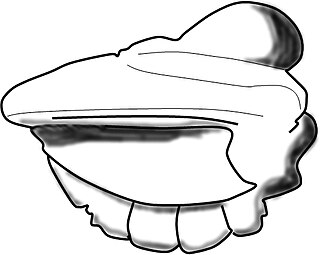
Trilobites are extinct marine arthropods that form the class Trilobita. Trilobites form one of the earliest known groups of arthropods. The first appearance of trilobites in the fossil record defines the base of the Atdabanian stage of the Early Cambrian period and they flourished throughout the lower Paleozoic before slipping into a long decline, when, during the Devonian, all trilobite orders except the Proetida died out. The last trilobites disappeared in the mass extinction at the end of the Permian about 251.9 million years ago. Trilobites were among the most successful of all early animals, existing in oceans for almost 270 million years, with over 22,000 species having been described.

Balcoracania dailyi is a small trilobite of the family Emuellidae. Its fossils have been found in south Australia and Antarctica.

Redlichia is a genus of redlichiid trilobite in the family Redlichiidae, with large to very large species. Fossils of various species are found in Lower Cambrian (Toyonian)-aged marine strata from China, Korea, Pakistan, the Himalayas, Iran, Spain, southern Siberia, and Antarctica, and from Middle Cambrian (Ordian)-aged marine strata of Australia.

Naraoia is a genus of small to average size marine arthropods within the family Naraoiidae, that lived from the early Cambrian to the late Silurian period. The species are characterized by a large alimentary system and sideways oriented antennas.
Abakania is an extinct genus of corynexochid trilobite in the family Corynexochidae. It lived during the Botomian stage, which lasted from approximately 524 to 518.5 million years ago. This faunal stage was part of the Cambrian Period.

Acidiscus is a genus of eodiscinid trilobite belonging to the family Weymouthiidae Kobayashi T. (1943), Order Agnostida Salter (1864). It lived during the Botomian stage = late Lower Cambrian Stage 4 ; the upper Botomian boundary corresponds to base of the Middle Cambrian, Miaolingian Series and Wuliuan stage.

Acimetopus is a genus of eodiscinid trilobite belonging to the family Weymouthiidae Kobayashi (1943), Order Agnostida Salter (1864). It lived during the Botomian stage. = late Lower Cambrian Stage 4 ; the upper Botomian boundary corresponds to base of the Middle Cambrian, Miaolingian Series and Wuliuan stage.

Bathydiscus is an extinct genus from a well-known class of fossil marine arthropods, the trilobites. It lived during the Botomian stage.

Cobboldites is a genus of eodiscinid trilobite belonging to the family Weymouthiidae, order Agnostida. It lived during the Botomian stage, which lasted from approximately 524 to 518.5 million years ago. This faunal stage was part of the Cambrian Period.
Laudonia is an extinct genus of trilobites that lived during the early part of the Botomian stage, which lasted from approximately 524 to 518.5 million years ago. This faunal stage was part of the Cambrian Period. There are currently two named species assigned to it.

Chelediscus is a genus of Eodiscinid trilobite belonging to the family Weymouthiidae Kobayashi T. (1943), Order Agnostida Salter (1864). The Treatise assigns this genus to the Calodiscidae; Cotton and Fortey (2005) however move it to the Weymouthiidae. Chelediscus lived during the later part of the Botomian stage.

Archaeaspis is an extinct genus of redlichiid trilobites. It lived during the late Atdabanian stage, which lasted from 521 to 514 million years ago during the early part of the Cambrian Period. The first specimens were first found in Siberia, where they were originally thought to have been endemic. Later, though, more specimen were found in the Inyo Mountains in Southern California. An Ediacarian proarticulatan was given the same name, Archaeaspis Ivantsov, 2001. This is however a junior homonym. The name Archaeaspis Repina in Khomentovskii and Repina, 1965, for the trilobite has priority. The new valid name for the proarticulate is Archaeaspinus Ivantsov, 2007.

Nevadella is an extinct genus of trilobites, fossil marine arthropods, with species of average size. It lived during the late Atdabanian stage, which lasted from 530 to 524 million years ago during the early part of the Cambrian Period.

Yunnanocephalus is a genus of ptychopariid trilobite. It lived during the late Atdabanian and Botomian stages, in what are currently Antarctica, Australia and China. It was a "moderately common" member of the Chengjiang Fauna. Yunnanocephalus is the only genus currently assigned to the Yunnanocephalidae family.
Lemdadella is an extinct genus of redlichiid trilobites that lived during the late Atdabanian stage, which lasted from 521 to 514 million years ago during the early part of the Cambrian Period.
Fallotaspidella is an extinct genus of redlichiid trilobites. It lived during the late Atdabanian stage, which lasted from 530 to 524 million years ago during the early part of the Cambrian Period.
Crepicephalus is an extinct genus from a well-known class of fossil marine arthropods, the trilobites. It lived from 501 to 490 million years ago during the Dresbachian faunal stage of the late Cambrian Period.

Pagetia is a genus of small trilobite, assigned to the Eodiscinid family Pagetiidae and which had global distribution during the Middle Cambrian. The genus contains 55 currently recognized species, each with limited spatial and temporal ranges.

Delgadella is a diminutive trilobite that lived during the late Lower Cambrian and has been found in Russia, Mongolia, Spain, Italy (Sardinia), Portugal, Morocco and Canada (Newfoundland). It can be recognized by its strongly effaced headshield and tailshield, with narrow but distinct furrows and borders along its margins, and three thorax segments.
Calodiscus is a genus of Eodiscinid trilobite in the family Calodiscidae. It lived during the late Lower Cambrian, with remains found in Canada, the United States, Greenland, The United Kingdom (England), Sweden, France, Germany, Italy (Sardinia), Kazakhstan, the Russian Federation and China.













